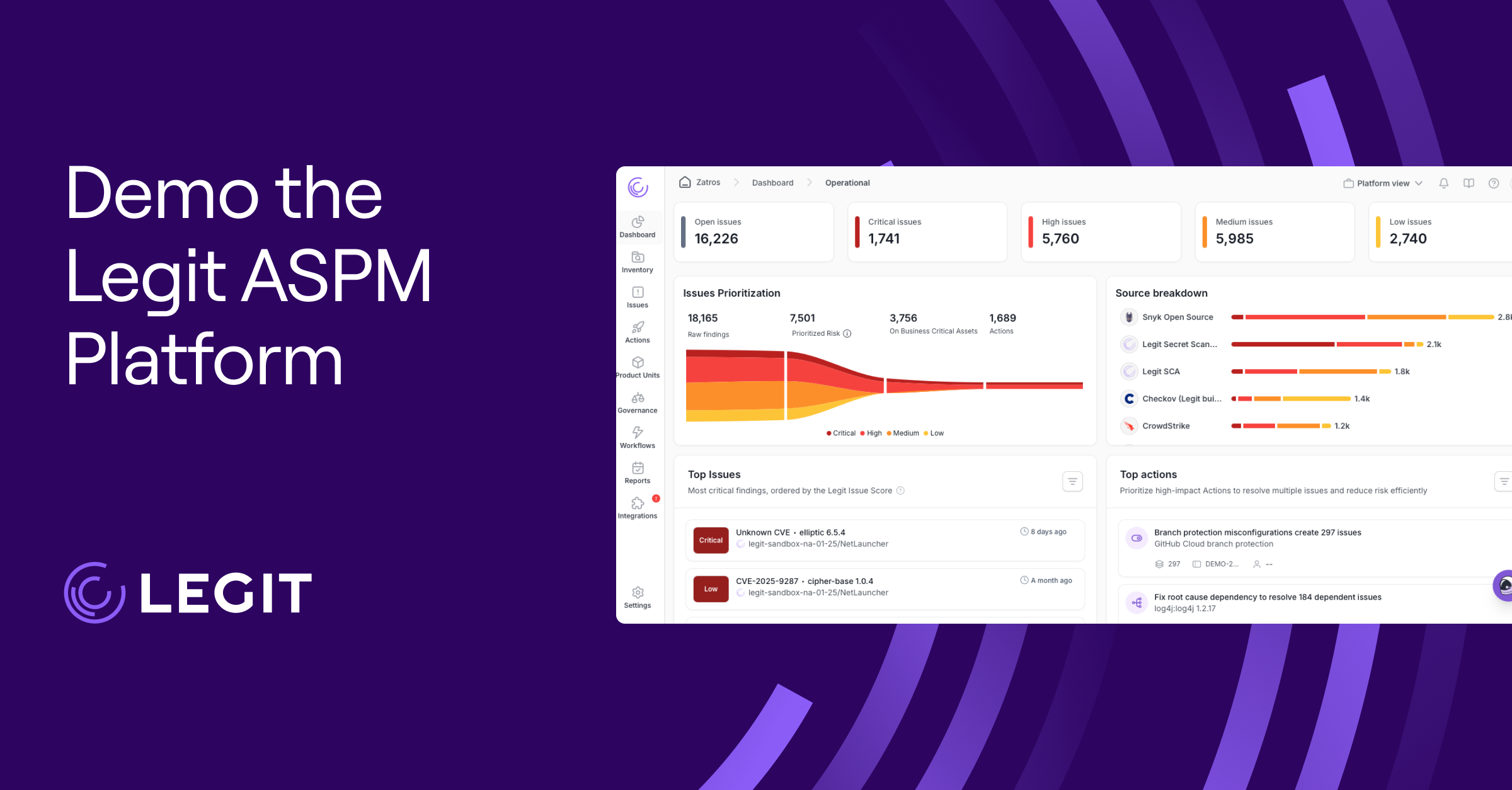AI has become a double-edged sword. The models that accelerate software delivery and boost productivity are weaponized against that same software. Now, attackers are training and modifying large language models (LLMs) to create phishing campaigns, write malicious code, and automate social engineering at scale.
This new wave of “dark AI” marks a turning point where threat actors use the same intelligence that powers innovation to execute cybercrime faster and more convincingly than ever.
This article will explain what dark AI is and how it’s changing the threat landscape, the dangers and challenges it presents, and what tools cybercriminals are using to exploit it. Then, learn how to defend your organization against AI-driven attacks.
What is Dark AI?
Dark AI is the deliberate use of artificial intelligence to coordinate and accelerate cyberattacks, especially using generative AI (GenAI) models. As AI in cybersecurity continues to evolve, defenders face adversaries using the same technologies with malicious intent. Think of it like a phishing email that reads like a colleague, code that mutates to avoid detection, or reconnaissance that never gets tired.
The technology behind dark AI is the same class you might deploy for productivity or code generation. What changes is intent and guardrails. Because these models learn fast and operate at machine speeds, they lower the barrier to entry for cybercriminals and increase the volume and quality of attacks defenders see.
Some dark AI tooling is purpose-built for abuse, while other attacks repurpose mainstream models through jailbreaking or illicit fine-tuning. You’ll also see “dark GPT AI”, which mimics friendly chatbots but ignores safety constraints, marketed in dark web channels.
What Are the Dangers of Dark AI?
Since GenAI has become widely accessible, organizations have seen a sharp increase in both incident volume and sophistication. A 2025 Cisco study found that 86% of business leaders report experiencing at least one AI-related incident in the past year, and a Darktrace report showed that 78% of Chief Information Security Officers say AI-powered threats are already having a tangible impact on their organizations.
Tools that once required in-depth technical skills are now packaged and sold across underground marketplaces and Telegram channels, enabling almost anyone to write polymorphic malware or exploit cloud APIs at scale. Attackers also use AI to fine-tune evasion tactics, generating endless iterations until they find a way through.
The biggest dangers of dark AI include:
- A growing attacker base: Pretrained dark AI tools give inexperienced users the capability to run large-scale campaigns once limited to advanced hackers.
- Data poisoning and model manipulation: Attackers can corrupt datasets or inject malicious prompts to alter model outputs and compromise internal AI systems.
- Continuous, adaptive attacks: Malicious models learn from every failed attempt, adjusting in real time to overwhelm static or rule-based defenses.
- Defense evasion: Some dark AI tools can continuously probe for weaknesses in detection logic to find gaps in security where threats can slip past filters and endpoint protection.
- Highly realistic social engineering: AI-generated written messages make attempts at phishing, business email compromise, and fraud nearly indistinguishable from legitimate communications.
- Synthetic media deception: Deepfake audio and video introduce new threats by enabling convincing impersonations and facilitating extortion attempts.
With 90% of organizations still unprepared to defend against AI-augmented attacks, the biggest challenge companies face is visibility and control. Defenders must counter automation with automation, embedding AI security across their environments to keep pace with machine-driven threats.
Dark AI in Action: The Tools Powering Modern Cyberattacks
While defenders can fight back with legitimate AI cybersecurity tools, attackers have developed their own arsenal too. Here are some examples of Dark GPT AI tools, ranging from those sold in underground forums to publicly available models that threat actors have weaponized:
- FraudGPT: As a malicious clone of ChatGPT sold through dark web marketplaces, FraudGPT’s conversational design lets users craft convincing scams without any coding experience. It can generate phishing messages, write malware, and create fake websites for fraud and identity theft, among other things.
- WormGPT: Built on a GPT-based model stripped of all safety controls, WormGPT specializes in producing harmful code and social engineering content. It's been linked to business email compromise attacks where AI wrote polished, context-aware emails that appeared legitimate.
- AutoGPT: Originally an open-source automation tool, bad actors can repurpose AutoGPT for malicious use. They configure AutoGPT to autonomously pursue defined goals, such as breaching networks or harvesting data. Once set, it adapts and refines its approach until it meets the objective.
- PoisonGPT: This proof-of-concept dark AI poisons LLMs with manipulated training data. It demonstrates to security teams how attackers could use this technique to inject misinformation or compromise AI models embedded within software supply chains.
- FreedomGPT: While marketed as a privacy-friendly tool, this uncensored GenAI application removes built-in restrictions on harmful content. This lack of moderation allows users to produce disinformation or offensive material that can spread unchecked.
- DarkBERT: Originally developed for cybersecurity research, DarkBERT is an LLM trained on dark web data. Malicious versions give threat actors access to underground black hat tactics for running sophisticated attacks.
How to Protect Against Dark AI
Dark AI approaches and procedures shift constantly, so your defenses should be quick to adapt. Understanding AI security risks is the first step.
The methods below suggest a few ways to cut exposure and stop attackers from turning AI models into entry points.
Educate Employees
Preparing teams to spot AI-enabled abuse in their workflows is a must. Show them real examples of tailored phishing or voice clones, and walk through how a fake vendor update or a bogus data request might look. Rehearse one simple rule: When a request could change anything related to money, data, or access, confirm it using a separate, trusted method before taking your next step.
Govern AI Usage and Access
Keep an approved list of AI tools and vendors, and run new ones through a thorough review process. (This applies to both AI services and AI developer tools used internally, from code completion assistants to custom-trained customer support models.) Grant access by role and data sensitivity, then recheck access and AI security on a regular basis. Block the ability to paste sensitive data into public AI, and log high-risk actions in your own environment.
Verify AI-Generated Output Before Taking Action
If AI can influence a decision, then require a source-of-truth check before you act. Treat AI output as unverified until it’s matched to an approved system of record or a second channel. For example, if an AI assistant suggests approving a vendor payment or granting system access, verify the request through your official ticketing system or by calling the requester directly.
Build the check into the tools your teams already use, such as email add-ins, and log the proof of verification (URL and file hash) with the request. With a clear chain of evidence, your team can cut fraud exposure and make audits and investigations faster.
Deploy Continuous AI Security Monitoring
Machine learning security operations (MLSecOps) is a discipline securing AI and machine learning systems end-to-end by wiring continuous monitoring and policy enforcement into your pipelines.
Build AI-aware controls into detection and response, not just the perimeter, and keep a live map of models, datasets, and third-party providers. This allows you to spot anomalies like unauthorized model access or suspicious prompt patterns before they escalate.
Protect Against Dark AI With Legit Security
Your defenses work best when integrated into a unified platform that gives you visibility across the entire AI attack surface. Legit Security’s AI-native ASPM gives you that view across code, cloud, and business systems.
Legit Security inventories models and prompts, flags weak points like exposed keys or over-privileged service accounts, and detects suspicious activity such as jailbreak attempts or automated account actions. You can set policy for model usage and data handling, then gate changes in pull requests and continuous integration and route high-risk events to the right owner with clear remediation steps.
Request a demo to see Legit secure AI-led development in your environment, end-to-end.
Download our new whitepaper.


